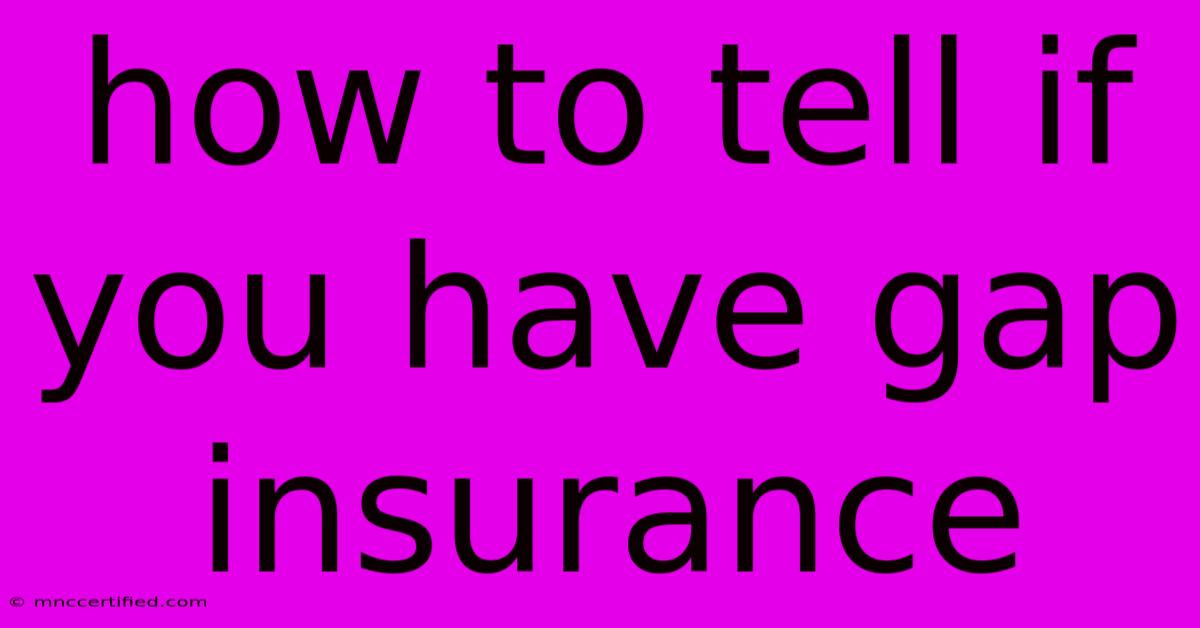How To Tell If You Have Gap Insurance

Table of Contents
How to Tell If You Have Gap Insurance: A Comprehensive Guide
Gap insurance can be a lifesaver if you're involved in an accident that totals your car. But knowing whether or not you have it can be confusing. You might have purchased it when you financed your vehicle, or it could be bundled with another insurance policy.
This guide will walk you through how to determine if you have gap insurance, helping you understand the nuances and ensuring you have the coverage you need.
What is Gap Insurance?
Gap insurance bridges the gap between what your car insurance pays out for a totaled vehicle and what you still owe on your loan.
Here's a simple example:
- You owe $20,000 on your car loan.
- Your car is totaled in an accident.
- Your car insurance pays you $15,000, the actual cash value of your car.
Without gap insurance, you would be left with a $5,000 gap to pay off the loan. Gap insurance covers this difference.
Why is Gap Insurance Important?
- Protects You from Financial Strain: Gap insurance can prevent you from having to pay a significant sum out-of-pocket, which can be a huge burden after an accident.
- Helps You Recover Financially: It ensures you don't have to start your car-buying journey again with debt hanging over your head.
How to Determine if You Have Gap Insurance
Here are a few ways to check:
1. Review Your Car Loan Documents
- Loan Agreement: Your loan agreement should clearly state if gap insurance was included.
- Disbursement Statement: Look for a line item specifically for "gap insurance" or a similar term.
- Loan Documents: Check any additional documents you received from the lender.
2. Contact Your Car Insurance Company
- Policy Review: Ask your insurance agent to review your policy for coverage details.
- Confirmation: Ask them to confirm if you have gap insurance and its terms.
3. Contact Your Loan Provider
- Loan Servicing: Your lender can also provide details about your loan and if any optional coverage was included.
4. Review Your Credit Card Statements
- Gap Insurance Premium: Look for charges that might indicate premiums for gap insurance.
5. Look for Gap Insurance Documentation
- Policy Documents: Check any policy documents you may have received.
- Car Dealer: If you purchased gap insurance at the dealership, ask them for copies of the paperwork.
What to Do if You Don't Have Gap Insurance
If you determine you don't have gap insurance, it's crucial to consider purchasing it.
Here's why:
- New Car Loans: Gap insurance is often recommended for new cars due to their rapid depreciation.
- Longer Loan Terms: The longer your loan term, the more your car depreciates, making gap insurance a worthwhile investment.
- High Loan Amount: If your loan amount is significant compared to your car's value, gap insurance can be particularly beneficial.
Speak to your insurance agent or loan provider about getting gap insurance. They can help you assess your needs and find the right coverage.
Remember:
- Gap insurance can provide financial peace of mind in case of an accident that totals your vehicle.
- Knowing whether or not you have it is essential to protect your financial well-being.
- Always double-check your car loan and insurance documents for details about gap insurance coverage.
- If you don't have gap insurance, consider getting it to protect yourself against potential financial hardship.
By understanding the steps to determine if you have gap insurance, you can ensure you have the coverage you need to stay financially secure in unforeseen circumstances.

Thank you for visiting our website wich cover about How To Tell If You Have Gap Insurance. We hope the information provided has been useful to you. Feel free to contact us if you have any questions or need further assistance. See you next time and dont miss to bookmark.
Featured Posts
-
Can I Cancel A Claim On Car Insurance
Nov 10, 2024
-
Watch Colorado Vs Texas Tech Football Time And Tv
Nov 10, 2024
-
Texas Capital Bank Investment Banking
Nov 10, 2024
-
Companies Similar To Oriental Trading
Nov 10, 2024
-
Insurance Requirements For Wood Stove
Nov 10, 2024